27 October 2021
Bye-bye daily snoozefest! Here are some fun ideas for engaging online daily for your remote software teams

Good morning! It’s whenever-you-start o’clock and high time for your morning daily. After the forced shift to a home office, everybody had to organize their daily meeting online, often with disastrous effects. Once a valuable meeting turned into a boring chore and people become inattentive and unmotivated. I’m here to show you that with minimal effort and by adding a bit of fun you will re-organize tiring calls into engaging online daily meetings.
Problem: how to increase people’s engagement during online daily meetings?
Have you ever had to repeat a question to another participant because that person wasn’t listening? Or maybe you have been caught not following the discussion until your name was mentioned?
It happens to everybody all the time. People doze off, daydream or think about the next task (or more probably about that delicious lunch waiting for them in the fridge). We’re only humans with a limited attention span (especially when video calls come into play) so there’s nothing inherently terrible about it.
It is worse when those situations become common during subsequent meetings. This is a clear signal that something should be changed in the way online daily is conducted. In this article, I’d like to show you some fun ways to increase the involvement of daily participants and stimulate their concentration.
According to the “fun theory”, the quickest, easiest, and most effective way to motivate people is by adding creative elements into routine things. Long story short, with a bit of fun, your can eventually change people’s attitudes and behavior for the better.
The most popular experiment has been led by Volkswagen – by installing piano stairs next to the escalator, they’ve managed to increase the number of people choosing stairs by 66%. See for yourself how genuinely fun it was!
All methods in this article have been tried and tested by various The Software House teams. It obviously took everybody a while to figure out what works for them and what doesn’t. So when putting new methods into practice, don’t get discouraged if your team doesn’t like every single one of them.
Virtual daily meetings vs Scrum
Work in the Scrum framework relies heavily on regular meetings. The most important and popular catch-up in the Scrum Guide is daily (also known as daily standup).
What is daily? It’s a fairly short team meeting, usually up to 15 minutes, taking place every single day (no wai! 😮). Everybody’s goal is to update the rest of the team about recent progress or share issues they’ve encountered. Daily is absolutely crucial when it comes to problem-solving and pushing the project forward.
Let’s think about what to do to help people to wake up, boost their energy levels, and really focus during those 15 important minutes.
💡 I’m not going to get into details about the daily meeting’s structure. My colleague has already covered all that in his piece:
Tired of being tired during online meetings? Maybe it’s “Zoom fatigue”
Before we will move forward I would like to mention a new dangerous syndrome, called “Zoom fatigue”, caused (maybe not directly by COVID-19) but by spending much more time for online calls. Obviously, it’s connected with all kinds of video calls, not only with Zoom. Zoom fatigue syndrome was described by professor Jeremy Bailenson who examined the psychological consequences of spending hours per day on video call platforms. Do you feel extra exhausted after a long day of online meetings? You’re definitely not alone.
Professor Bailenson distinguished four main reasons why it happens:
- Too much high-intense, close-up eye contact.
Both the amount of eye contact we engage in on video chats, as well as the size of faces on screens is unnatural. - Seeing your own face on self-view video chats non-stop is tiring.
Most platforms use unnaturally small square-shaped views of what you actually look like. It’s like being constantly exposed to your own reflection in a mirror. - Video chats reduce our natural mobility.
In-person and audio conversations allow you to walk around, sit down, stand up… But during video conferences, you need to stay in the same spot otherwise you’ll fall out from the camera eye. And walking around would surely distract other participants. - The cognitive load during video chats goes through the roof.
Face-to-face interaction with nonverbal communication is natural for us to read. But with video calls, we need to make an extra effort to show and receive signals.
If you want to read more about it, you can check out this piece from Bailenson himself.
Idea 1: Physical exercise 🤸♀
The Scrum Guide doesn’t specify in what form daily meetings should be concluded, does it? I mean, we used to meet in a conference room, laptops on the table, behinds on the seats. If people work remotely they’re probably sitting by their desk too. When the routine bites hard and energies are low, propose changing a formula.
What if the daily standup was a real stand up indeed?
Stand up meaning “stand up from your chair” not “tell us a joke, John”. But we’ll get to that later…
Standing up from your desk is a simple, yet effective procedure, forcing participants to talk briefly and more straight-to-the-point. If you work with an exceptional bunch of Snorlaxes, introduce some physical exercises. We’ll see who’s gonna prolong their online daily while planking (that’s a hardcore version, please don’t torment people).
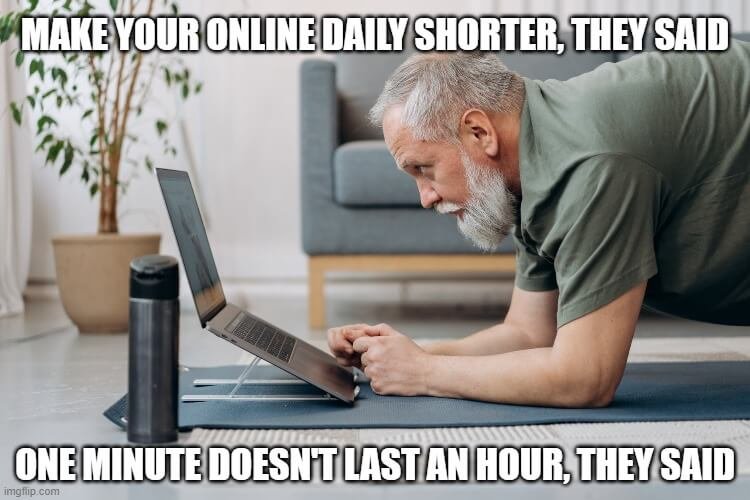
This option is not always possible – not everybody has conditions to work out at home, or doesn’t feel comfortable with it. So what else is there, you ask?
Idea 2: Virtual reality 🤖
Changing the environment is very beneficial. Personally, I need a change of scenery every now and then. I’ve adapted well to pandemic-imposed remote work but nevertheless, I like to change my perspective once in a while.
Ideally, I wish we could all travel to workations (work + vacations) but unfortunately, the pandemic situation is still a bit wobbly with various restrictions all over the world.
If changing the environment is impossible, improvise!
If you want to travel, without leaving the house, you can use a certain tool (not Google Maps) my team is crazy about right now – Mibo.
Mibo is a virtual reality combined with a video chat. Your avatar is a little robot with your camera roll hovering like a TV-shaped head that can run around freely. There are a few places full of activities you can visit. We’ve already held online daily on an island surrounded by the blue sea, forest, volleyball court, and theatre stage. You can even take a group photo!
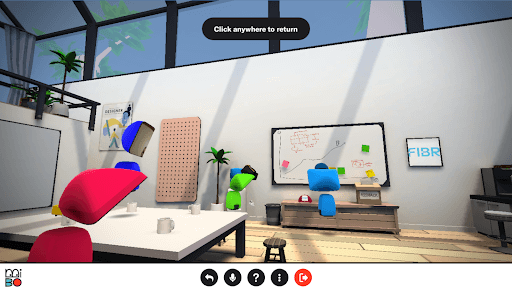
Thanks to Mibo our online daily became more lively. It’s easier to focus when you’ve let off steam while crushing your coworkers in billiards or paper basketball. Then you just share your screens and discuss the tasks. There’s even an option to work in smaller groups, as the conversations are only heard when people are around us, so nobody disturbs the rest.
I highly recommend Mibo!
Idea 3: Drawing ✍️
Another solution widely used by The Software House teams is drawing. Instead of boring “I’ve done this and that” reporting, and going through each task on mindnumbing boards in Jira, our team leader created a space for us on a virtual board.
My favorite tool so far is Miro. You can draw connections between tasks we’re working on, cross off things we’ve finished, and highlight problems. But we also share our feelings and moods.
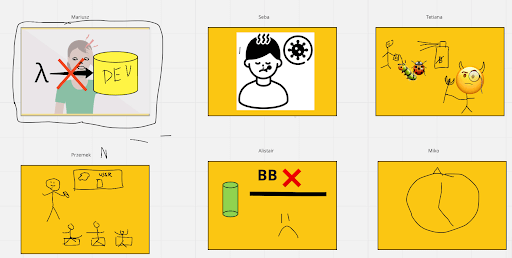
Obviously, we’re no artists so the drawings are of appalling quality, which just adds a lot of humor to our dailys. The experience is excellent, not only everybody has fun but we also stimulate our creativity while drawing (and solving the drawings of others).
Idea 4: Sounds of music 🎶
We try to use different methods so we don’t fall into a routine. Another activity proposed by our team leader was “soundtrack of the day”. A sound that accompanies us on a given day. It can be anywhere: dribbling of a ball, stirring tea in a cup, cat’s purr, or the neighbors forging walls (Does every building in the world suffered from a pandemic inside a pandemic – sudden boom on home-grown Bobs the builders?). The game was supposed to make each participant repeat the sound, but eventually, we got into sending links to our favorite songs). Next stop, maybe the team’s collaborative Spotify playlist?
Idea 5: “Punishments” for latecomers ⏰
Has this ever happened to you (rhetorical question, really)? Meeting’s already in progress, people cover important topics, and then somebody joins the meeting. It’s the least of the problem if they do it silently. It’s worse when they start explaining, apologizing, and asking to repeat everything they’ve missed. Destabilization of online daily meetings at its finest.
In order to avoid those situations, we’ve introduced a moderator punishment – the last person to come shares their screen, presents tasks, and serves as a meeting leader. It turned out that hardly anyone likes to do it. In fact, everybody absolutely hates it. As a result, people are queuing up on the meeting link 10 minutes before the online daily starts.
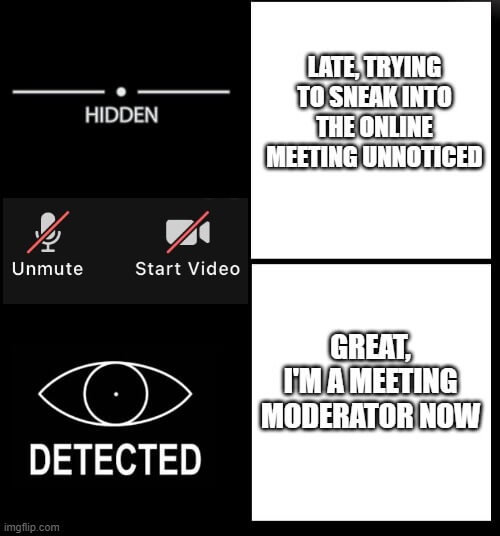
While researching this article, I’ve learned that another team uses stand-up comedian punishment. The last person to come must tell a funny, yet cheesy joke. Apparently, people have joke files prepped for the situation…
Idea 6: Joke of the day 🤣
Speaking about jokes, we’ve also tried out the Wheel of Fortune for funnies. How does it work? At the end of each daily, we draw who’s going to tell a joke the next day. We prefer IT industry-related content but we won’t shy away from humorous bangers about something else.

The emotions when the wheel is spinning and everybody’s scared that they are going to be next… Anti Las Vegas.
Idea 7: Quizzes 🧩
It is also worth trying little competitions to take place during daily. We came up with a quiz game that engages the entire team. How does it work? At the end of each week, one person is randomly chosen to be responsible for running daily meetings next week. However, they get to prepare a quiz or puzzle for the rest of the team. Participants receive points for correct answers that are being summed up at the end of the week. The winner receives vouchers for a free food delivery (nice way to start the weekend, yummy.
As far as I know, there have been a few themes already: TV series, movies, random trivia, geography. The most creative ones were brought by musicians – a pianist and a guitarist – who organized the “Name that Tune” quiz.
It’s a lot of fun and with a little adrenaline kick, people tend to wake up faster.
Idea 8: Background photos 📸
Technically nothing new, I assume at this point everybody working via video chats knows about the possibility of changing video backgrounds. Creators of video communicators really try to diversify colors, shapes, and whatnot to design cool backgrounds behind our backs. However, this is still a short-term, static change and might get boring after a while.
Unless you take it a step further. One of our Project Managers came up with a “spot the location” game. At the end of each daily, he changes his background photo into a geographical or fictional location (Hawaiian beach or Batman’s cave, anything goes). The rest has to guess where the background came from. The winner receives bragging rights, undoubted satisfaction, and +10 to respect in the team.
Idea 9: Sticky notes 📒
If you’re looking for something less competitive, I have a solution for that too. Sticky notes, available in tools like Miro or Figma.
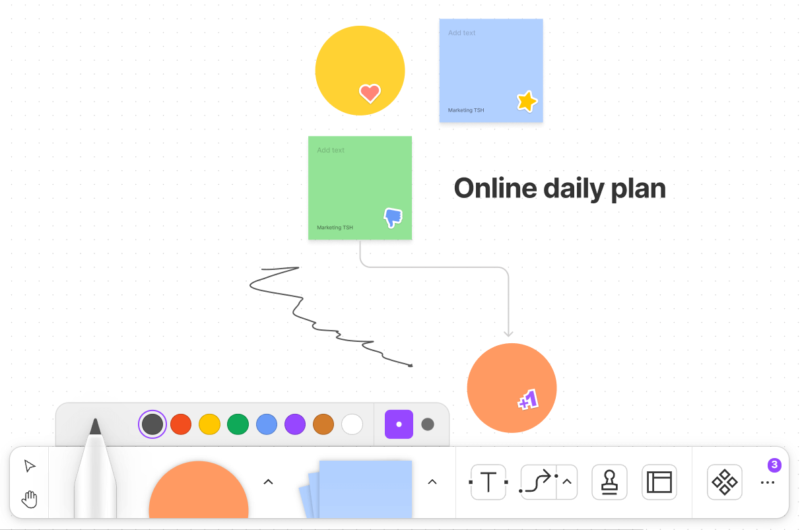
Sometimes during daily meetings, a lot is being said and agreed on but immediately after people get memory failures and make rounds to get a reminder of what’s going on. Some people are visual learners and they work better when they can see, rather than hear information. That’s why sticky notes are super useful for busy teams that have to plan and arrange a lot of different projects.
A few TSH teams use virtual sticky notes to organize their daily, transfer all the arrangements to the notes, and attach them to a shared online board. Notes can have different colors, shapes, and there’s even a voting system with various stickers.
You too can organize engaging online daily
As you can see, there are so many possibilities to turn a routine, sometimes very monotonous online daily meeting into something attractive and activating.
Of course, you cannot completely abandon this important meeting but I recommend that once in a while you change it into something more fun and relaxed. There will be a few laughs, the team will get to know each other better, which may pay off in the weeks and months to come.
We don’t have to suffer together!
So, how does your online daily meeting looks like? Do you do anything fun? Share your ideas!

